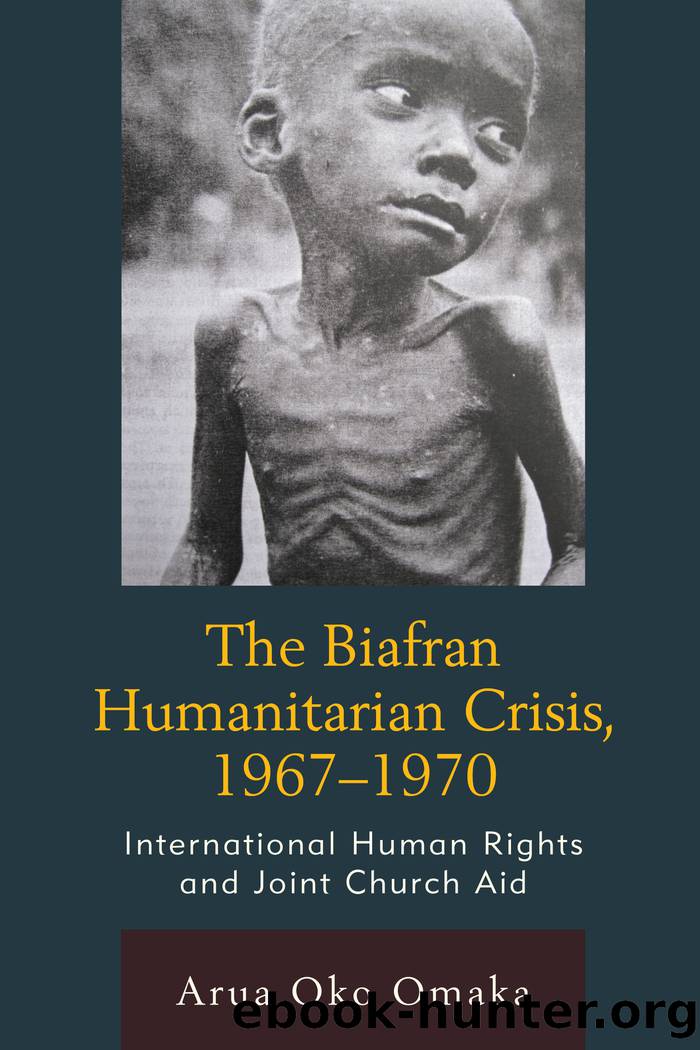The Biafran Humanitarian Crisis, 1967-1970 by Omaka Arua Oko;

Author:Omaka, Arua Oko;
Language: eng
Format: epub
Tags: undefined
Publisher: Fairleigh Dickinson University Press
Published: 2012-08-15T00:00:00+00:00
Relief Organization and Distribution
Food Supplies
JCAâs relief supplies from different churches in Europe and North America were centrally coordinated by a consortium of Catholic and Protestant relief agencies with an operational base in São Tomé. The Roman Catholic Church operated under the general umbrella of Caritas Internationalis while the Protestant churches were organized under the auspices of the WCC. The strategic role of São Tomé earned it the nickname âMercy Island.â[46] When relief supplies were brought into the Biafran airport from São Tomé, they were moved to the WCC central stores at Awo-Omanma, near Uli airport and the Caritasâ central stores located at Ihioma. The JCA had two relief distribution networks in Biafra. The Protestant churches had a provincial distribution system, while the Catholic Church under Caritas adopted a diocesan method of distribution.[47] In the Protestant provincial system, relief supplies at the central stores were distributed among representatives of the various provinces in Biafra. Distribution according to provinces was based on the existing provinces created by Colonel Ojukwu in December 1966.[48] Using five-ton trucks, the provincial stores further distributed the supplies to the refugee camps, feeding centers, sick bays, and hospitals, where thousands of women and children began gathering at 4:30 a.m. for the only meal they could get for two days. Most people brought their own basin-like pans. In refugee camps, camp committees distributed food to registered refugees. At the feeding centers, cooked meals were distributed to all children, pregnant women, nursing mothers, and destitute individuals in the villages. The feeding centers provided protein food to both registered and nonregistered refugees who needed more protein.[49] The Catholic Caritas, on the other hand, used clergy-run diocesan stores to get supplies to parishes, where priests managed their distribution.[50]
In each of the provinces, a provincial secretary, assisted by a refugee worker, coordinated relief activities and work with refugees.[51] This individual liaised with a refugee committee that also had representation from the WCC, the ICRC, and Caritas. In addition to providing regular and up-to-date records of the number of refugee camps and their respective
populations, the provincial secretary also documented the number of hospitals, sick bays, orphanages for refugee children, and patients who attended or were admitted to kwashiorkor clinics. It was the duty of the secretary to ensure that the Biafran nurses and doctors assigned to the refugee camps by the Ministry of Health did the jobs for which they drew supplies. Although the provincial secretary was primarily responsible for keeping such information, the members of the committee also kept their own records. Those records provided key data and information that were used in the allocation of relief goods.
An important attribute of church humanitarianism during this period was the understanding and cooperation between the WCC and Caritas in relief distribution. This helped minimize duplication and overlapping of services.[52] The organizations sometimes pooled their relief supplies and worked together in relief distribution in order to increase their reach and impact. The level of cooperation enjoyed by the two church groups, however, depended on the individuals involved.
Download
This site does not store any files on its server. We only index and link to content provided by other sites. Please contact the content providers to delete copyright contents if any and email us, we'll remove relevant links or contents immediately.
Cecilia; Or, Memoirs of an Heiress — Volume 1 by Fanny Burney(31352)
Cecilia; Or, Memoirs of an Heiress — Volume 3 by Fanny Burney(30950)
Cecilia; Or, Memoirs of an Heiress — Volume 2 by Fanny Burney(30907)
The Great Music City by Andrea Baker(21621)
We're Going to Need More Wine by Gabrielle Union(18087)
Bombshells: Glamour Girls of a Lifetime by Sullivan Steve(13120)
Pimp by Iceberg Slim(12947)
All the Missing Girls by Megan Miranda(12776)
Fifty Shades Freed by E L James(12464)
Talking to Strangers by Malcolm Gladwell(11909)
Norse Mythology by Gaiman Neil(11902)
Crazy Rich Asians by Kevin Kwan(8373)
Mindhunter: Inside the FBI's Elite Serial Crime Unit by John E. Douglas & Mark Olshaker(7850)
The Lost Art of Listening by Michael P. Nichols(6485)
Enlightenment Now: The Case for Reason, Science, Humanism, and Progress by Steven Pinker(6414)
Bad Blood by John Carreyrou(5782)
The Four Agreements by Don Miguel Ruiz(5533)
Weapons of Math Destruction by Cathy O'Neil(5049)
We Need to Talk by Celeste Headlee(4881)
